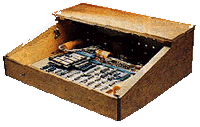|

The Apple I was the result of the development efforts of Steve
Wozniak, Steve Jobs, and Ron Wayne. It was developed, not in
a garage, but in the bedroom of Steve Wozniak's home on 11161
Crist Drive in Los Altos (the house number was later changed
to 2066). Steve Wozniak built the printed circuit-board, while
Ron Wayne wrote the Apple-1 Operation Manual at his home. Steve
Jobs did what he does best, advertising the Apple I to friends
and family. They first previewed the Apple I in action during
a May 1976 meeting of the Homebrew Computer Club. Paul Terell,
the owner of the Byte Shop, the only computer store chain at
the time, was impressed by what he saw and promised to buy 50
fully assembled computers for $500 each. As you can see, the
machine was intended for hobbyist that would add ASCII keyboards
and displays after buying the bare circuit board. It was not
meant to be pre-built with fully-assembled displays and attachments.
Jobs insisted it could be done and with the help of Woz, Bill
Fernandez (who introduced Jobs to Woz) and Daniel Kottke (a friend
of Jobs) they were able to build by hand all 50 of the motherboards
on the second-to-last day before their loaned parts were due.
They were not the "fully assembled" computers Terell
had asked for, but he paid the men the cash they needed to pay
off loans and make a good profit. Apple later sold the Apple
I for $666.66 before being replaced by the much more practical
and user friendly Apple II.
Look at a screen
shot of the Apple-1 display.
|

